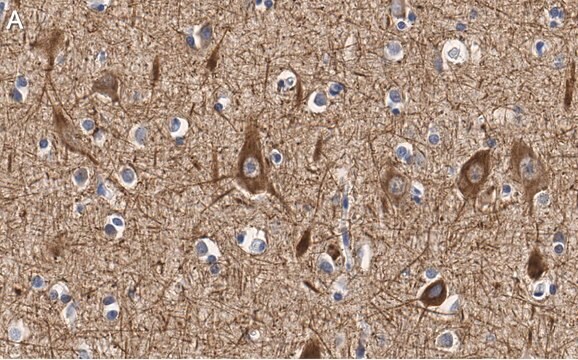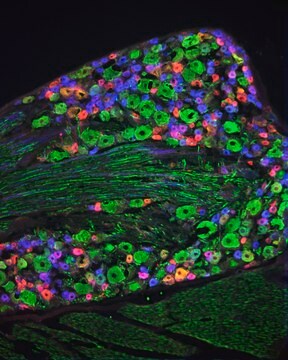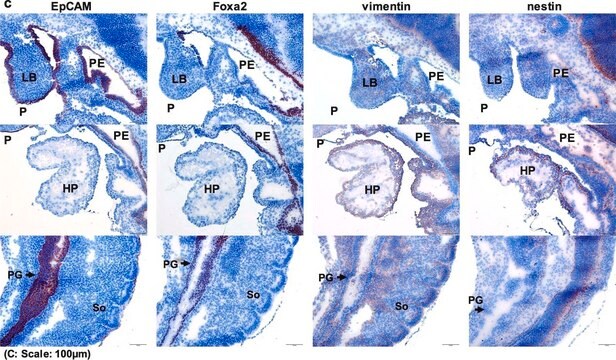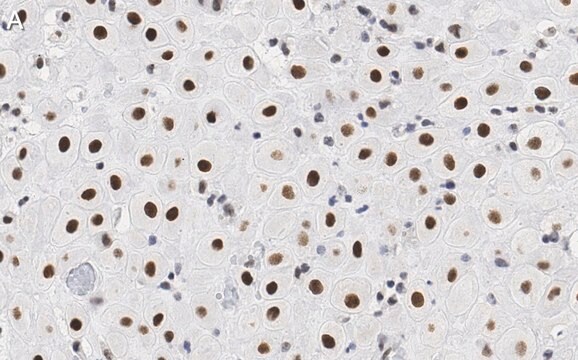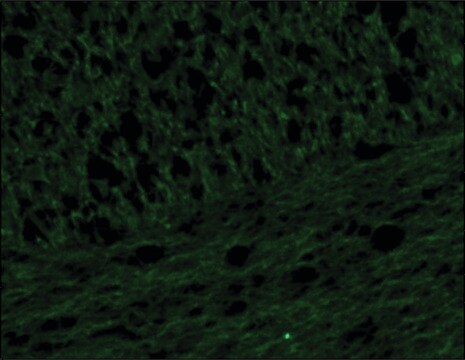MAB1592-C
Anti-Neurofilament NF-H Antibody, phosphorylated Antibody, clone NP1
clone NP1, from mouse
Synonym(s):
Neurofilament heavy polypeptide, NF-H, 200 kDa neurofilament protein, Neurofilament triplet H protein
About This Item
Recommended Products
biological source
mouse
Quality Level
antibody form
purified antibody
antibody product type
primary antibodies
clone
NP1, monoclonal
species reactivity
canine, mouse, human, rat
species reactivity (predicted by homology)
chicken (based on 100% sequence homology), bovine (based on 100% sequence homology), porcine (based on 100% sequence homology)
packaging
antibody small pack of 25 μg
technique(s)
ELISA: suitable
immunohistochemistry: suitable (paraffin)
western blot: suitable
isotype
IgG1κ
NCBI accession no.
UniProt accession no.
shipped in
ambient
target post-translational modification
phosphorylation (not specified)
Gene Information
bovine ... Nefh(528842)
chicken ... Nefh(417020)
dog ... Nefh(442940)
human ... NEFH(4744)
mouse ... Nefh(380684)
pig ... Nefh(100156492)
rat ... Nefh(24587)
General description
Specificity
Immunogen
Application
Immunohistochemistry Analysis: A representative lot detected Neurofilament NF-H in Immunohistochemistry applications (Benson, D.L., et. al. (1996). J Neurocytol. 25(3):181-96; Boylan, K., et. al. (2009). J Neurochem. 111(5):1182-91).
Western Blotting Analysis: A representative lot detected Neurofilament NF-H in Western Blotting applications (Benson, D.L., et. al. (1996). J Neurocytol. 25(3):181-96; Boylan, K., et. al. (2009). J Neurochem. 111(5):1182-91).
ELISA Analysis: A representative lot detected Neurofilament NF-H in ELISA applications (Boylan, K., et. al. (2009). J Neurochem. 111(5):1182-91; Toedebusch, C.M., et. al. (2017). J Vet Intem Med. 31(2):513-520; Mashita, T., et. al. (2015). J Vet Med Sci. 77(4):433-8).
Neuroscience
Quality
Immunohistochemistry Analysis: A 1:50 dilution of this antibody detected Neurofilament NF-H in human cerebral cortex tissue.
Target description
Physical form
Storage and Stability
Handling Recommendations: Upon receipt and prior to removing the cap, centrifuge the vial and gently mix the solution. Aliquot into microcentrifuge tubes and store at -20°C. Avoid repeated freeze/thaw cycles, which may damage IgG and affect product performance.
Other Notes
Disclaimer
Not finding the right product?
Try our Product Selector Tool.
Storage Class Code
12 - Non Combustible Liquids
WGK
WGK 2
Certificates of Analysis (COA)
Search for Certificates of Analysis (COA) by entering the products Lot/Batch Number. Lot and Batch Numbers can be found on a product’s label following the words ‘Lot’ or ‘Batch’.
Already Own This Product?
Find documentation for the products that you have recently purchased in the Document Library.
Our team of scientists has experience in all areas of research including Life Science, Material Science, Chemical Synthesis, Chromatography, Analytical and many others.
Contact Technical Service